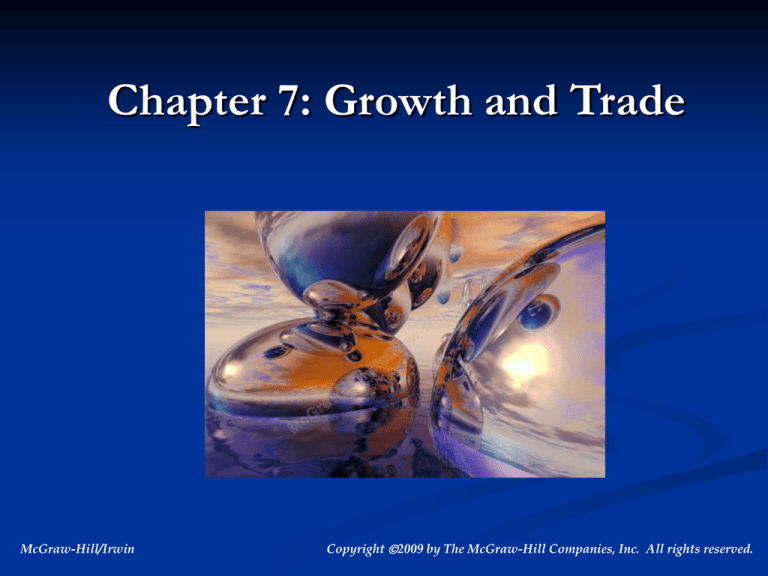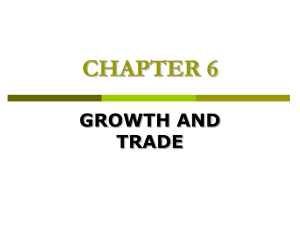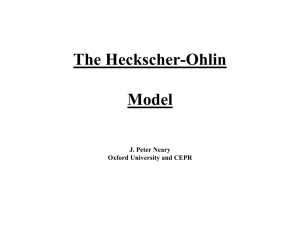
Chapter 7: Growth and Trade
McGraw-Hill/Irwin
Copyright 2009 by The McGraw-Hill Companies, Inc. All rights reserved.
7-2
7-3
7-4
7-5
1.Introduction
Objective
To understand the relationship
between economic growth and
international trade, in particular,
the effects of growth on trade
and welfare.
7-6
Introduction
Contents
Sources of economic growth
Balanced versus Biased growth
Rybczynski Theorem and Dutch
Disease
Immiserizing growth
Effects of trade on growth
7-7
2.Sources of growth
Definition of economic growth
Increase in productive capabilities
Growth in Gross Domestic Products
(GDP) (constant price)
Expansion of PPC
7-8
Expansion of PPC
7-9
Sources of growth
Increases in factor resources
labor resources
Capital
Land
Improvement in production
technologies
7-10
Sources of growth and PPC
Increase in labor
resources
7-11
Sources of growth and PPC
Technical progress
in wheat
production
7-12
3.Balanced vs Biased Growth
均衡增长与偏向性增长
Balanced growth
Concept
7-13
7-14
Sources of Balanced Growth
Increases in all factors of
production at the same rate
Technical progress of the
same magnitude in both
industries
7-15
Effects of Balanced Growth
(under constant relative price)
Production
Consumption
Trade
Welfare
7-16
40% growth
Terms of trade=
1 yard for 1 bushel
7-17
Biased Growth
偏向性增长
The concept
Economic growth biased
toward production of one
product
7-18
7-19
Sources of Biased Growth
Increases of factors of
production at different rates
Technical progress of different
magnitudes in two industries
7-20
Effects of Biased Growth
(under constant relative price)
Production
Consumption
Trade
Welfare
7-21
Relative price:
1 yard for 1
bushel
7-22
4 Growth in Only One Factor
要素增长
单一
In the 2x2x2 model, assuming
relative price is constant, what
changes will happen to production
with growth in only one factor ?
7-23
Growth in labor resources
in the USA
7-24
Rybczynski Theorem
罗勃津斯基定理
Under constant prices, growth in a
country’s endowment of one
factor will result in both an
increase in the output of the
product that uses the growing
factor intensively and a decrease
in the output of the other product.
7-25
Tadeus Rybczynski
罗勃津斯基
(1923-1998)
Polish-born English economist
Known for Rybczynski theorem
(1955)
Studied at the London School of
Economics.
Investment banker with Lazard
(瑞德)
7-26
The Dutch Disease
“荷兰病”
Discoveries of vast natural
gas deposits in the North
Sea in the 1960s resulted
in deindustrialization of
the Dutch manufacturing
industries.
7-27
5 Effects on the Country’s Terms of
Trade
Small country
Large country
7-28
Effects of Growth on a Large
Country
Reduced willingness to
trade and improvement in
terms of trade
7-29
S2
C2
7-30
Effects of Growth on a Large
Country
Increased willingness to
trade and deterioration in
terms of trade
7-31
S2
C2
7-32
Immiserizing Growth
贫困化增长
Jagdish Bhagwati
巴格沃蒂(1958)
Columbia University
7-33
S2
C2
7-34
Conditions for immiserizing growth
to occur
Growth is strongly biased toward
expanding export supply and affects
world price.
Foreign demand is price inelastic.
The country is heavily engaged in
trade so that terms of trade loss can
offset production gains.
7-35
6 Openness to Trade Affects
Growh
Access to better technology
(Capital goods)
Competitive pressure and
incentive to innovate
7-36
Summary
Sources of growth
Balanced vs biased growth
Rybczynski Theorem
Immiserizing growth
Trade and growth
7-37












